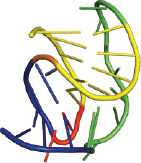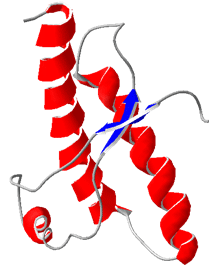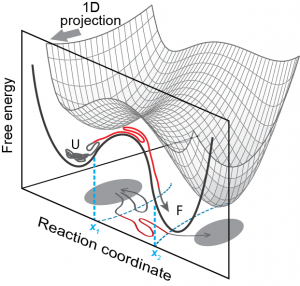Research Overview
Our research combining tools from physics, chemistry, and molecular biochemistry to investigate how biological molecules form complex 3D structures in the process known as ‘folding.’ Proteins and nucleic acids are made of linear polymer chains, but interactions within these chains drive them to fold up spontaneously into specific structures. Folding is one of the most important examples known of structural self-assembly: biological molecules must form into the correct structure in order to function properly, and incorrect folding can lead to a wide range of diseases.
We approach folding from the level of single molecules, observing them directly as their structure changes in response to perturbations. Single-molecule approaches offer important advantages in studying folding: we can observe transient changes at high resolution, catalogue different types of behaviour, and map the sequence of steps taken by each molecule as the folding reaction progresses. The primary experimental method we use is single-molecule force spectroscopy, where we attach molecules to sensitive laser tweezers, apply force to induce structural changes, and measure the resulting changes in the length of the molecule as parts of it unfold or refold. Laser tweezers, awarded the 2018 Nobel prize for their applications in biology, provide an exceptionally sensitive and precise probe of molecular motions, able to detect motions at the near-atomic scale in real time. We supplement force spectroscopy studies with fluorescence spectroscopies, more traditional ensemble biochemical and enzymatic assays, computational simulations, and theoretical modeling to build as comprehensive a picture of the folding as possible.
Our current measurements of unfolding and refolding under mechanical tension can offer important new insights into folding because they allow us to follow the progress of the folding reaction in individual molecules, with high spatial and temporal resolution. By measuring the extension of a molecule as a function of time at various forces, individual folding and unfolding events can be observed, the free energy and rates can be determined directly, intermediate states along the folding pathway can be observed, and the shape of the energy landscape governing the folding transition can even be deduced.
The main research centers on 3 themes: (1) the folding of RNA structures from viruses that play important functional roles like regulating gene expression or RNA decay, (2) the folding of proteins and how it can go wrong (‘misfolding’ that often also leads to aggregation) to produce disease, and (3) measuring the microscopic motions involved in folding and using them to test physical theories.
Research Areas
 RNA Folding
RNA Folding
 Protein Folding & Aggregation
Protein Folding & Aggregation

